

<< Go Back up to Region ‘United Kingdom: outside London’
| Follow Mike Hume’s Historic Theatre Photography: |  |
 |
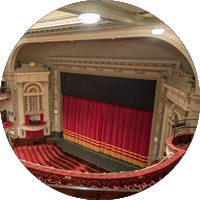
Architect: John Fairweather
First Opened: 12th August 1929 (96 years ago)
Closed as a Super Cinema: 24th November 1973
Reopened After Renovation by Lothian Regional Council: 1st June 1980
Reopened After Renovation by Apollo Leisure: 28th August 1993
Website: edinburgh-playhouse.co.uk 
Telephone: 0844 871 3014 
Address: 18-22 Greenside Place, Edinburgh, EH1 3AA 
The Edinburgh Playhouse opened in August 1929 as a super-cinema; Scotland’s second largest theatre or cinema with 3,040 seats. After operating as a super-cinema for many years the theatre was refurbished in the late 1970s for live entertainment. The Playhouse is Scotland’s largest theatre, and the largest all-seated theatre in the UK, by seating capacity.

 Detailed Information
Detailed InformationThe Playhouse was built by John Patrick Maguire and Fred Lumley, who had formed Edinburgh Playhouse Ltd in 1928 to build a variety theatre in the city.
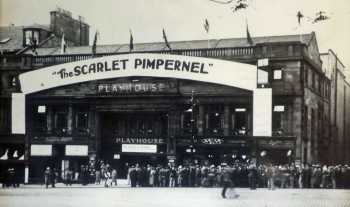
The theatre was designed by Glasgow-based architect John Fairweather, who took inspiration from the size and splendour – but not the architectural design – of the Roxy Theatre in New York, and other huge theatres he saw in America designed by Thomas Lamb, which he’d visited while on a fact-finding visit to the United States.
The Playhouse was designed on a vast scale, and at the time of its opening it was Scotland’s second largest cinema or theatre by seating capacity. Greens Playhouse in Glasgow was the largest with 4,400 seats.
The Playhouse’s seating capacity of 3,040 was split across three levels: Stalls (main floor / Orchestra seating) with 1,500 crimson coloured seats, the Circle (front balcony, in front of the cross-aisle) with 680 purple-coloured seats, and the Balcony (rear balcony, behind the cross-aisle) with 860 gold-coloured seats. The original colour scheme was described as having “tones of ivory and stone [that] predominate on the walls, and the roof is decorated with bands of pale green leaves intersected with gold at intervals”.
Although originally conceived and designed as a variety theatre that would present a mixture of live theatre and film, by the time the Playhouse opened in mid-1929 “the talkies” had taken hold and it was decided that running the theatre as a super-cinema would be the best financial decision. The inclusion of dressings rooms, an orchestra pit, and a fly tower would prove instrumental to the theatre’s survival in future years.
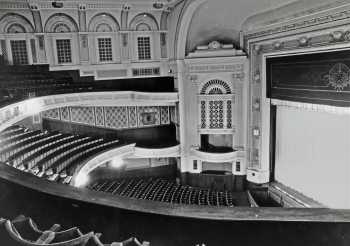
The cavetto architrave above the proscenium arch was lit with concealed cove lighting in a variety of colours such that it could simulate the changing colours of a morning sunrise, a golden sunset, or the deep blue of the sky on a summer evening. The auditorium’s central double coffered ceiling could be similarly lit with a variety of colours using hidden cove lighting.
The Playhouse opened on Monday 12th August 1929 at 2pm with two talking pictures and a silent film: The Doctor’s Secret (1929)  , Miss Information (1928)
, Miss Information (1928)  , and The Fleet’s In (1928)
, and The Fleet’s In (1928)  . Carriages were at 5pm.
. Carriages were at 5pm.
According to research by Clive Chenery, the Playhouse quickly established itself as a successful cinema showing first run movies and special event films such as the Grand National, sports events, and boxing matches.
In 1932 Laurel and Hardy made an onstage appearance to promote their latest film, The Music Box (1932)  .
.
By the 1970s the theatre operating as a single-screen cinema was not profitable. It was considered too costly to split the auditorium into multiple screens. The Playhouse closed in late November 1973, and the last film to be screened was Live and Let Die” (1973)  .
.
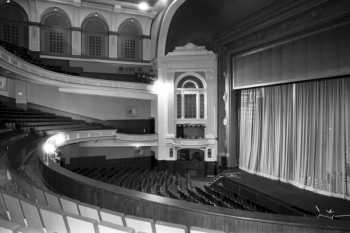
The theatre was sold to a developer – the Maxwell Property Company, whose subsequent application to demolish the building (an office block was to be built on the site) was turned down by Lothian Regional Council – twice! The theatre sat dormant, however Gordon Lucas and Larry McGuire, former employees of the Playhouse, set up the Playhouse Preservation Action Group and began a campaign to save the Playhouse. Thousands of signatures were collected, and in late 1974 the building was granted Category B listed status.
In 1975 the Edinburgh Playhouse Society was formed, agitating for the Playhouse being reopened and used for large scale productions including national opera and ballet, at a time when there was both local and national drives to establish a national theatre for Scotland in Edinburgh. Billy Connolly, Elton John, and Yehudi Menuhin all joined the campaign to save the Playhouse.
After much campaigning, the Playhouse was purchased for £135,000 by the local council (then Lothian Regional Council) in 1979. The theatre was refurbished by the council (orchestra pit extended, stagehouse refitted, and the auditorium partially refurbished) and reopened at the start of June 1980 with a charity gala in aid of the Variety Club of Great Britain  . At that time, the Playhouse was the largest theatre by seating capacity (3,059 seats) in the United Kingdom.
. At that time, the Playhouse was the largest theatre by seating capacity (3,059 seats) in the United Kingdom.
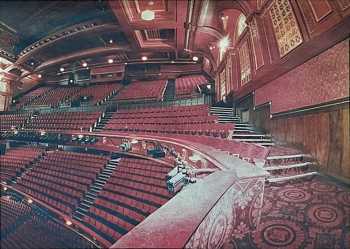
While the Playhouse did host a few operatic performances, opera and ballet did not form the backbone of the Playhouse’s programming. Concerts, comedy, and films became the staple with performers such as Barbara Dickson, Ella Fitzgerald, Elvis Costello, Gary Numan, The Who, Bruce Springsteen, Billy Connolly, Russ Abbot, and Steve Coogan, with film screenings ranging from Disney’s Fantasia (1940)  to The Rocky Horror Picture Show (1975)
to The Rocky Horror Picture Show (1975)  – and everything in between.
– and everything in between.
In 1986 Apollo Leisure acquired the theatre and brought a string of big name shows to Edinburgh. In mid-1993 they embarked on a £2 million refurbishment (the new auditorium colour scheme was deep crimson with gold highlights) however a fire broke out the day before reopening resulting in smoke and water damage to backstage areas and extensive smoke damage to the auditorium. Extensive work was carried out around the clock and the reopening was pushed back by two weeks, to late August 1993. The reopening production (a double bill production of Bluebeard’s Castle and Erwartung by the Canadian Opera Company  as part of the Edinburgh International Festival
as part of the Edinburgh International Festival  ), was followed by a five-month run of Les Misérables, opening on 23rd September 1993.
), was followed by a five-month run of Les Misérables, opening on 23rd September 1993.
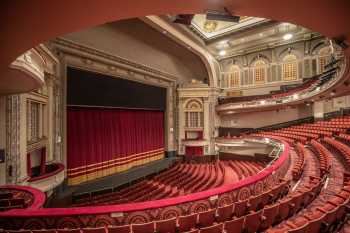
This first – and limited – UK and Ireland tour of Les Misérables played just three of the largest theatres between the two countries: the Palace Theatre in Manchester for 12.5 months and the Point Theatre in Dublin for three months, before arriving in Edinburgh. The set was so vast that it was destroyed after the Edinburgh engagement, being too big to tour to other UK theatres.
Many large-scale musicals followed Les Misérables including Miss Saigon, The Phantom Of The Opera, The Lion King, Mary Poppins, and Chitty Chitty Bang Bang.
Following SFX buying-out Apollo Leisure in 1999, who were then purchased by Clear Channel in 2001, Ambassador Theatre Group (rebranded in April 2024 as ATG Entertainment  ) now own and operate the Edinburgh Playhouse having purchased SFX in 2009.
) now own and operate the Edinburgh Playhouse having purchased SFX in 2009.
The building’s Category B listed status was upgraded to Category A status by Historic Scotland  in 2008 as part of the Cinema Thematic Study 2007-08
in 2008 as part of the Cinema Thematic Study 2007-08  , a collaboration between Historic Environment Scotland and the Cinema Theatre Association Scotland
, a collaboration between Historic Environment Scotland and the Cinema Theatre Association Scotland  .
.
 Video from our YouTube channel:
Video from our YouTube channel: Listed/Landmark Building Status
Listed/Landmark Building Status (6th June 2008)
(6th June 2008) (12th December 1974)
(12th December 1974) How do I visit the Edinburgh Playhouse?
How do I visit the Edinburgh Playhouse?Backstage Tours last approximately 60 – 90 minutes. Tour schedule depends on productions and theatre availability so check the theatre’s Backstage Tour website page  for the current schedule.
for the current schedule.
Tours do not include a show ticket. Backstage & stage and backstage access is subject to availability and cannot be guaranteed. Under 18s must be accompanied by an adult. Tours may be cancelled last minute due to company rehearsals. Routes may change and involve a number of stairs. If you have any access needs, please do get in touch  before your visit.
before your visit.
 Further Reading
Further Reading , the premier music hall and theatre historic site in the UK.
, the premier music hall and theatre historic site in the UK. , with lots of information and many photos over the years.
, with lots of information and many photos over the years. .
. , a 3-min video short on YouTube.
, a 3-min video short on YouTube. , an October 2012 longform article by Scottish Television’s Laura Piper.
, an October 2012 longform article by Scottish Television’s Laura Piper. Technical Information
Technical Information Photos of the Edinburgh Playhouse
Photos of the Edinburgh PlayhousePhotographs copyright © 2002-2026 Mike Hume / Historic Theatre Photos unless otherwise noted.
Text copyright © 2017-2026 Mike Hume / Historic Theatre Photos.
For photograph licensing and/or re-use contact us here  . See our Sharing Guidelines here
. See our Sharing Guidelines here  .
.
| Follow Mike Hume’s Historic Theatre Photography: |  |
 |